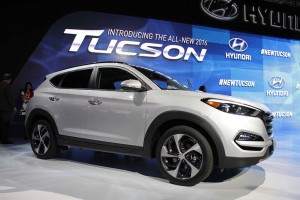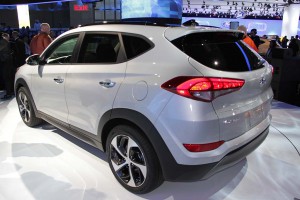
Hyundai introduced the new Tucson in New York. It followed the global introduction, which happened in Geneva.
Hyundai’s new 2016 Tucson SUV made its American debut today in New York. The new design, debuted globally at the Geneva Motor Show, takes it a step forward.
With a sleeker design that moves even further away from the classic, boxy SUV look of earlier versions, the new Tucson is clearly aimed at building Hyundai’s share of the booming global utility vehicle market.
“Our new compact SUV will be a big step forward for the Hyundai brand globally,” said Peter Schreyer, president and chief design officer of Hyundai Motor Group, in Geneva.
The new Tucson gets a focus on safety and when equipped with Automatic Emergency Braking, is expected to receive a Top Safety Pick+ from the Insurance Institute for Highway Safety (IIHS).

The new Tucson is clearly aimed at building Hyundai’s share of the booming global utility vehicle market.
For 2016, advanced safety technologies such as Automatic Emergency Braking with pedestrian detection, Lane Departure Warning System, Blind Spot Detection, Rear Cross-traffic Alert, Lane Change Assist, Backup Warning Sensors and standard rearview camera also will be offered.
The Tucson comes with two powertrain offerings, including the base model’s Nu engine family, a 2.0-liter, direct-injected four-cylinder with an estimated 164 horsepower and 151 lb.-ft. of torque, coupled with a six-speed automatic transmission getting 26 combined mpg.
The Eco, Sport and Limited models offer a new, Gamma engine family, 1.6-liter turbocharged, direct-injected four-cylinder with an estimated 175 horsepower and 195 lb.-ft. of torque and delivers a combined 29 mpg.
(Hyundai pulls wraps off 2016 Tucson in Geneva. For more, Click Here.)
The Tucson will arrive at Hyundai dealers in July.
(Click Here for details about Hyundai green lighting the Santa Cruz concept.)
The Tucson was first introduced in 2004 as a 2005 model. The current version was redesigned for the 2010 model-year.
(To see more about Hyundai possibly opening a second U.S. plant, Click Here.)
The 2016 revamp underscores the increasing competitiveness of the compact crossover market, which has been flooded by new offerings from both mainstream and luxury brands over the last several years. Small CUVs have become one of the world’s fastest-growing segments and are forecast to grow significantly faster than the rest of global automotive market into the next decade.
